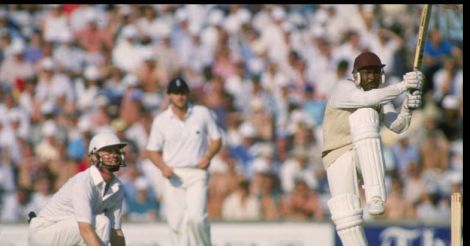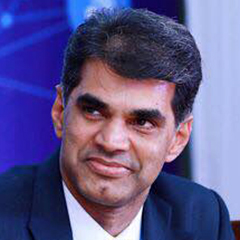One piece of cricketing news that would have given lovers of the game world over plenty of cheer during the week that just went by was the brilliant victory recorded by the West Indies in the second Test of the on going series against England at Headingley, Leeds. This win assumes added significance as it came in the aftermath of the side losing the first Test inside three days, with as many as 19 wickets falling in a day. It appeared at that juncture that West Indies cricket had reached the absolute pits, to a point of no return, when suddenly they sprang a pleasant surprise by bouncing back strongly to win the next Test. The phrase “glorious uncertainties”, which was coined for this game and the situations that arise therein has never been so apt as for describing the current performances and fortunes of willow wielders from the Caribbean islands!
West Indies cricket team is a truly multi national one as it is the representative side for nine sovereign states besides territories of countries such as the UK, the US and the Netherlands. Though a relic of British colonial rule over the islands of this region, this grouping of countries and their coming together solely for the purpose of playing a game has stood the test of time, despite many of the erstwhile colonies emerging independent. West Indies had come into existence as a cricket team towards the end of nineteenth century though they were granted formal membership of Imperial Cricket Conference (predecessor of present day International Cricket Council) only in 1926 and played their first Test in 1928. They soon established themselves as a competitive side and Learie Constantine, who was brilliant batsman, fiery fast bowler and outstanding fielder in any position, is considered as the first cricketing great that these islands produced.
Worrell's legacy
Though they had a set of extremely talented players, the West Indies started playing as a team only after Frank Worrell took over the captaincy in 1960, ending the convention that the side would always be led by “whites”. He exhorted the players to rise above the national and regional affiliations, a malaise that had plagued the side hitherto. Worrell himself set a tremendous personal example as a perfect gentleman and one of the finest ambassadors of the game. He motivated a whole lot of talented cricketers like Gary Sobers, the greatest all-rounder that game has seen, Wes Hall, the fearsome fast bowler, Rohan Kanhai and Lance Gibbs, who all went on to serve the side with distinction.
 Gordon Greenidge was one of the finest openers of his generation. File photo: Getty Images
Gordon Greenidge was one of the finest openers of his generation. File photo: Getty ImagesThough the West Indies had become a formidable side from 1960s onwards, they became the unchallenged numero uno in world cricket during late 1970s and 80s. Led astutely by Clive Lloyd, the side could boast of some of the best batsmen of all time in Viv Richards and Gordon Greenidge, besides the skipper himself. However, what gave a distinct teeth to the team was the presence of four fast bowlers, each of them capable of hurling the red cherry at speeds in excess of 90 miles per hour. These quicks bounded in one after the other subjecting the hapless batsmen to a relentless barrage of bouncers and yorkers, raising fears over personal safety as much as challenging their ability to score runs and keep their wickets intact. They were almost invincible during this period, the occasional blip in the form of loss to India in the 1983 World Cup final notwithstanding, and none of the other sides could even come close to offering them a good fight.
The slump
The decline of West Indies cricket started after the exit of great cricketers who played for them till the turn of the century. Though Brian Lara was, without doubt, one of the greatest batsmen in contemporary cricket, he did not possess the skill sets required for leading a side like the West Indies. Lara could not become the type of motivational cricketer or leader in the mold of other West Indian heroes like Constantine, Worrell, Sobers, Lloyd and Richards. The end result was that despite possessing a bunch of talented players who came up with some brilliant individual performances, the West Indies could not win Test matches and One-Day Internationals with the same authority that they used display in their prime. The rot of West Indies set in during the time when Lara was at the helm and could not be stemmed after that.
As the team started losing more matches, following for the game started dwindling in the Caribbean islands. The newer generation made no secrets of their preference for basketball, which had become very popular and, in addition, offered better financial rewards. The English county cricket, and the clubs there, which had acted as a nursery for aspiring cricketers from these islands, had fallen into difficult times. The West Indies Cricket Board too failed to read and appreciate the changes happening in the world around them and did not take any action to stem the rot, instead preferring to fight with individual players over their remuneration. In a situation characterized by absence of any inspirational heroic figures, poor performances by their side, lack of financial security from the game and an apathetic cricket administration, the youngsters in the West Indian islands could not be blamed for deciding to give cricket a miss and switching over to other avenues such as basketball and music. It appeared that existence of game in these islands was under serious challenge, unless major attempts were made to salvage it.
The fall from the pedestal on which they had perched themselves was so steep that West Indies did not even qualify to play in the Champions Trophy held in England in June. Their rankings in Test matches had slipped down to 8, while in One-Day Internationals, it was even lower at 9. It was only in T20 that they could salvage some pride retaining a No. 4 ranking. There have certainly been some occasional bright sparks in between. Like the victory in the Champions Trophy in 2004, entering the finals of that tournament again in 2006 and being crowned winners in the ICC T20 in 2012 and 2016. However, these had appeared more like flash in the pan rather than any sustained recovery.
The continued poor performance of the side in Test matches pointed towards a deeper malaise affecting their game. Even worse than the position in the ranking order was the general lackadaisical approach of the side, indicating an undue willingness to roll over and expose their soft underside at the smallest opportunity. This was a far cry from the proud and tough set of cricketers who had made sides like England and Australia eat humble pie and ensured that former English captain Tony Greig would regret forever shooting his mouth off and using the word “grovel”.
It was in these circumstances that their tour of England commenced this summer. When they were walloped in the first Test at Birmingham by a whopping margin of an innings and 209 runs, it appeared that West Indian cricket had moved beyond the stage of redemption. However, like the proverbial falcon, they rose, virtually from the ashes, to script a glorious victory in the next Test. Statisticians have pointed out that out of 642 occasions when a side has been set a target in excess of 300 runs in the last innings of a match, only 29 chases have been successful! Shai Hope, who scored a century in each innings, and Kraigg Brathwhite, who narrowly missed doing so, showed that they had scant regard for statistics as they took the team towards the target of 322, scarcely missing a beat.
Cricket pundits have been quick to hail this victory as a miracle. It certainly ranks as one, given the circumstances under which it happened. However, prudence demands that one exercises discretion before predicting that this win could mark a turnaround in the fortunes of West Indian cricket. Yet, the performances of Hope and Brathwaite have given West Indian supporters plenty of scope for cheer. More importantly it has filled the mind of cricket lovers with the hope that the West Indies would resurrect and emerge back on cricketing center stage, taking their rightful place as a champion side that they were, before the long period of blight commenced.
(The author is a former international umpire and a senior bureaucrat)
Read more from Vantage Point | When Kapil's Devils brought the nation together

























 Shai Hope guided West Indies home in the second Test against England at Headingley. Getty Images
Shai Hope guided West Indies home in the second Test against England at Headingley. Getty Images
